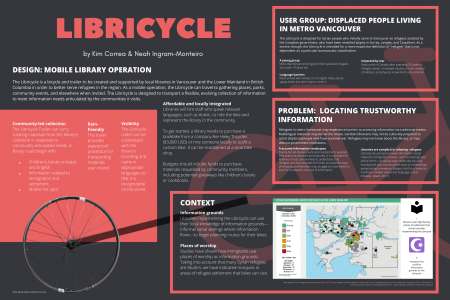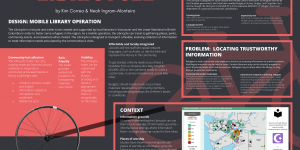
Design Project - Report (PDF of written assignment)
Bibliography for Libricycle Poster
My classmate and I designed a bookbike service for refugees in Vancouver, B.C. In order to design a service that met their information needs, we first had to understand the user group. Using Census data to learn about the countries of origin of recent refugees, we then deepened our research around Syrian refugees, looking at reports from government agencies, news articles, and academic studies. This helped us identify demographic information including age, settlement locations, languages spoken, socioeconomic trends, and professional backgrounds. We also drew on academic literature about the ways that displaced people interact (or don’t) with libraries in the places where they are resettled, about how social capital can help newcomers access information, and about the ways that libraries enact the state’s assimilation goals. We decided that a bookbike service would enable libraries to go to refugee communities in a simple, adaptable, and low-budget way. We designed the Libricycle in a way that would encourage libraries to seek a reciprocal exchange with refugee communities, so that the libraries are not uncritically carrying out assimilation agendas, but also are inviting and responding to the input, ideas, and participation of the refugees they connect with.

This project developed from learning about the role of context in information-seeking behavior; when building an information service, a dynamic understanding of a user group’s context is essential.